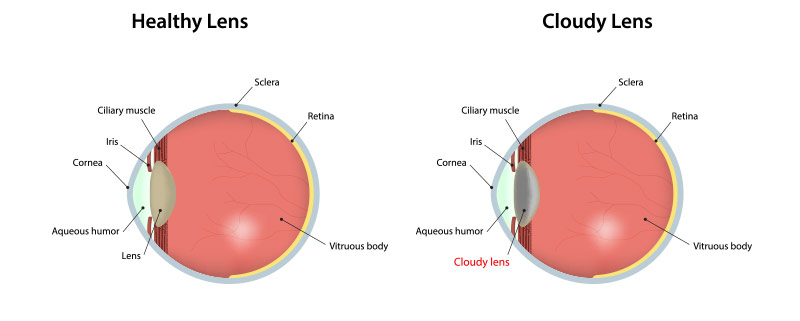
Cataracts
What Are Cataracts?
Cataracts are a painless clouding of the internal lens of the eye. Because they block light from passing through the lens, cataracts make it difficult to see clearly and can even cause blindness over time. Cataracts are progressive, meaning they worsen with time. Most cases occur in older people, but sometimes they can be seen in younger people as well.
How Your Vision Is Affected By Cataracts
Light enters the eye and passes through the lens. The lens of the eye focuses light onto the retina, which transmits visual signals through the optic nerve to the brain. Clouding of the lens due to cataracts results in blurring of the images you see. Other problems with the eyes can also cause blurry vision, but cataracts produce some characteristic symptoms.
Cataract Symptom: Blurry Vision
The most common symptom of cataracts is seeing blurry images at any distance. People may describe their vision as foggy, cloudy, or filmy. Cataracts get worse with time, and less light reaches the retina. It may be especially hard for people with cataracts to see and drive at night.
Symptom
Glare
Glare, or sensitivity to light, is another symptom of cataracts. It can be difficult for a person with cataracts to see in bright sunlight. Indoor lights may begin to seem too bright, or they may appear to have halos around them. Glare from oncoming headlights can cause problems with driving at night.
Double Vision
Diplopia, or double vision, when looking with one eye can be another symptom of cataracts. This is not the same as diplopia that arises from improper alignment of the eyes. The double vision seen with cataracts occurs even when you look through only one eye.
Color Changes
Cataracts also affect color vision. Some colors may appear faded, and things may acquire a yellowish or brownish tint. This may not be noticed at first, but with time, distinguishing between blues and purples can be difficult.
Cataract Symptom: Second Sight
The phenomenon known as “second sight” is another characteristic of cataracts. In this situation, the cataract acts as a stronger lens, temporarily improving the ability to see things at a close distance. People who formerly needed reading glasses may no longer need them. However, as the cataract worsens over time, this temporary improvement in near vision disappears.
Cataract Symptom: New Prescription
People with cataracts often need frequent changes in their eyeglasses or contact lenses because their vision deteriorates over time.
What Are the Causes of Cataracts?
It is not precisely understood why people get cataracts. Aging is a known risk factor. Other factors that may also play a role in the development of cataracts include:
- Smoking
- Excessive use of alcohol
- Diabetes
- Trauma to the eyes
- Extended use of corticosteroids
How Are Cataracts Diagnosed?
Cataracts can be diagnosed with an eye exam. The eye exam contains a vision test and an examination of your eyes using a slit lamp microscope. The pupils are dilated with special eyedrops to provide a better view of the back of the eye, where the retina and optic nerve are located.
Cataract Surgery
Surgery to remove cataracts may be required if the related vision loss cannot be corrected with glasses or contact lenses. Cataract surgery involves removing the cloudy natural lens and replacing it with an artificial lens. The operation is usually done on an outpatient basis and is very safe and effective. For those who need surgery on both eyes, the surgery is usually done on one eye at a time.
What to Expect After Cataract Surgery
After surgery, your eyes may itch and feel sensitive to light for a few days. You may need to wear a shield or glasses for protection, and you may be prescribed eyedrops to speed the healing process. It takes about 8 weeks for the eye to completely heal even though changes in vision are apparent shortly following the surgery. You may still need glasses for distance vision or reading, after the surgery, and it is likely that you will require a new prescription after your eye has healed.
Cataracts Prevention Tips
Remember, there are steps you can take to lower your risk of getting cataracts:
- Don’t smoke.
- Always wear a hat or sunglasses in the sun.
- Keep diabetes well controlled.
- Limit alcohol consumption.

Comments closed
No comments. Leave first!